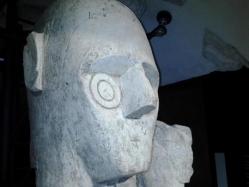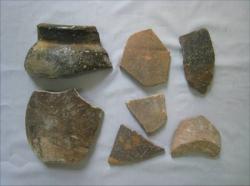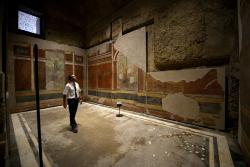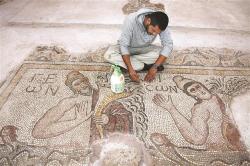INSTITUTE OF ANTHROPOLOGY
ONLINE COURSES / COURS A DISTANCE
FALL TERM : OCTOBER 2014
REGISTER NOW
ITALIE –  Monte Prama -Archeologists working in Sardinia's southwestern region have uncovered a new 'giant', officials reported on Thursday. Archaeologists from the Superintendency of Cagliari and Oristano and Cagliari and Sassari universities dug up another monumental sandstone giant at the Monte Prama excavation site in Oristano on Thursday morning. The Monte Prama site is home to the Giants of Monte Prama, ancient stone figures from the Bronze-age Nuragic civilization that were discovered en masse in the early 1970s. When reconstructed, the sandstone figures are approximately 2.5 meters in height. The remains of the giant sculpture, along with additional finds, were placed in storage.
Monte Prama -Archeologists working in Sardinia's southwestern region have uncovered a new 'giant', officials reported on Thursday. Archaeologists from the Superintendency of Cagliari and Oristano and Cagliari and Sassari universities dug up another monumental sandstone giant at the Monte Prama excavation site in Oristano on Thursday morning. The Monte Prama site is home to the Giants of Monte Prama, ancient stone figures from the Bronze-age Nuragic civilization that were discovered en masse in the early 1970s. When reconstructed, the sandstone figures are approximately 2.5 meters in height. The remains of the giant sculpture, along with additional finds, were placed in storage.
http://www.ansa.it/english/news/lifestyle/arts/2014/09/25/sardinian-archaeologists-find-giant_649ccf08-eff5-40c5-bbb3-fc8ae89afcd2.html?
ROYAUME UNI –  Scarborough -A mapping company claim to have found an image showing an old fort beneath Scarborough Castle.In September 2014 Merlindown was conducting surveys over the North Sea and coastal areas and, upon examining the images made their discover. A spokesman for the company said: “What we have discovered at Scarborough Castle, as revealed on this deepscan image, is further early antiquity, including a hill fort and ramparts together with more than 30 round huts of an early settlement. There is a potential large henge with sarsen stones at its centre (not shown here but on other images obtained during the search) and another henge with sarsen stones within the hill fort on a much smaller scale. “Other defences, probably from the 17th century onwards to the Second World War, are visible on site. Numerous small-to-medium objects have also been discovered. For security reasons the image shown here is not absolutely distinct, but it does show the extent of the hill fort and numerous other features. “Merlindown has taken numerous other images which show a greater amount of finer detail together with many other sites of potential interest beyond the borders of this image. The image shown here, along with the others obtained, would allow anyone following up our searches with ground surveys to locate the archaeology without carrying out initial and possibly time consuming random searches. “The geophysics tests at Scarborough Castle appear to have only covered the area within the castle compound around the keep, not extending anywhere beyond those confines.“All our findings are outside of their zone of primary interest.
Scarborough -A mapping company claim to have found an image showing an old fort beneath Scarborough Castle.In September 2014 Merlindown was conducting surveys over the North Sea and coastal areas and, upon examining the images made their discover. A spokesman for the company said: “What we have discovered at Scarborough Castle, as revealed on this deepscan image, is further early antiquity, including a hill fort and ramparts together with more than 30 round huts of an early settlement. There is a potential large henge with sarsen stones at its centre (not shown here but on other images obtained during the search) and another henge with sarsen stones within the hill fort on a much smaller scale. “Other defences, probably from the 17th century onwards to the Second World War, are visible on site. Numerous small-to-medium objects have also been discovered. For security reasons the image shown here is not absolutely distinct, but it does show the extent of the hill fort and numerous other features. “Merlindown has taken numerous other images which show a greater amount of finer detail together with many other sites of potential interest beyond the borders of this image. The image shown here, along with the others obtained, would allow anyone following up our searches with ground surveys to locate the archaeology without carrying out initial and possibly time consuming random searches. “The geophysics tests at Scarborough Castle appear to have only covered the area within the castle compound around the keep, not extending anywhere beyond those confines.“All our findings are outside of their zone of primary interest.
http://www.thescarboroughnews.co.uk/news/local/fort-discovered-under-castle-1-6861579
CHINE - Qian’an - The remains of an ancient campsite for nomadic emperors from the Liao Dynasty (907—1125) has been unearthed in China, archaeologists said. The campsite, found in Qian’an county in north—east China’s Jilin province, served as an administrative centre during the reign of the nomadic Khitans, although the regime’s capital city was in inner Mongolia. Feng Enxue, an archaeologist and professor with Jilin University, told Xinhua on Wednesday that emperors of the Liao dynasty usually had four campsites where they lived during the four seasons. In spring and summer, when it was warmer, they moved to the north while in autumn and winter they settled in the south. The ruins, once the spring campsite, were first found in 2009 and have undergone excavation since August this year. Situated on a vast grassland, the campsite is next to a small lake. Tradition dictates that a Khitan emperor would give the first wild goose he hunted and the first fish caught as offerings for prosperity every year. Overall it consists of four parts. The biggest, three kilometres wide, is about one—third the size of the entire campsite, containing as many as 900 bases for camping. While archaeologists have yet to disclose the overall size of the campsite, it is believed to be the largest ever found in China. During the past two months, archaeologists unearthed more than 100 cultural relics, including tiles, pottery, porcelain, copper coins and Buddha statues. Site workers also discovered pottery shards, coal cinder and pieces of broken iron—ware, which proved the Khitans dwelled there for short periods.
http://www.thehindu.com/news/international/world/ancient-chinese-nomadic-campsite-unearthed/article6445129.ece
VIET NAM –  Truong Sa- Archaeologists yesterday made public numerous artefacts they had found during the latest excavation off the Truong Sa, Nam Yet, Phan Vinh and Son Ca islands in Khanh Hoa Province. During the excavation in the province's Truong Sa District in June, archaeologists examined the whole area and opened a one-square-metre-wide excavation pit in Truong Sa island. They found four pre-historic ceramic pieces, a piece of a ceramic bowl belonging to the Tran dynasty, two white pottery pieces inscribed with deep-blue patterns of the Le dynasty and various glazed terracotta pieces of the 18th and 19th centuries. The objects unearthed during the excavation in Nam Yet and Son Ca islands include a number of glazed terracotta pieces of the 18th century. Deputy head of the Viet Nam Institute of Archaeology Bui Van Liem, who was a member of the excavation team, said, "The finds continue to reinforce the conclusions made from previous excavations in 1993, 1994, and 1999. "The results clearly are scientific proof of the marine activities of the prehistoric inhabitants as well as the Vietnamese people in the country's history. These materials contribute to affirming vividly and strongly the territorial sovereignty of the country over the land and waters of Viet Nam."
Truong Sa- Archaeologists yesterday made public numerous artefacts they had found during the latest excavation off the Truong Sa, Nam Yet, Phan Vinh and Son Ca islands in Khanh Hoa Province. During the excavation in the province's Truong Sa District in June, archaeologists examined the whole area and opened a one-square-metre-wide excavation pit in Truong Sa island. They found four pre-historic ceramic pieces, a piece of a ceramic bowl belonging to the Tran dynasty, two white pottery pieces inscribed with deep-blue patterns of the Le dynasty and various glazed terracotta pieces of the 18th and 19th centuries. The objects unearthed during the excavation in Nam Yet and Son Ca islands include a number of glazed terracotta pieces of the 18th century. Deputy head of the Viet Nam Institute of Archaeology Bui Van Liem, who was a member of the excavation team, said, "The finds continue to reinforce the conclusions made from previous excavations in 1993, 1994, and 1999. "The results clearly are scientific proof of the marine activities of the prehistoric inhabitants as well as the Vietnamese people in the country's history. These materials contribute to affirming vividly and strongly the territorial sovereignty of the country over the land and waters of Viet Nam."
http://english.vietnamnet.vn/fms/art-entertainment/112629/art---entertainment-news-24-9.html
ITALIE –  Rome - Lavishly frescoed rooms in the houses of the Roman Emperor Augustus and his wife Livia are opening for the first time to the public Thursday, after years of painstaking restoration. The houses on Rome's Palatine hill where the emperor lived with his family are re-opening after a 2.5 million euro ($3.22 million) restoration to mark the 2,000 anniversary of Augustus's death -- with previously off-limit chambers on show for the first time. From garlands of flowers on Pompeian red backgrounds to majestic temples and scenes of rural bliss, the rooms are adorned with vividly coloured frescoes, many in an exceptional condition.
Rome - Lavishly frescoed rooms in the houses of the Roman Emperor Augustus and his wife Livia are opening for the first time to the public Thursday, after years of painstaking restoration. The houses on Rome's Palatine hill where the emperor lived with his family are re-opening after a 2.5 million euro ($3.22 million) restoration to mark the 2,000 anniversary of Augustus's death -- with previously off-limit chambers on show for the first time. From garlands of flowers on Pompeian red backgrounds to majestic temples and scenes of rural bliss, the rooms are adorned with vividly coloured frescoes, many in an exceptional condition.
http://artdaily.com/news/73014/Roman-Emperor-Augustus--frescoed-rooms-unveiled-for-first-time-after-years-of-restoration#.VCLUP5R_vqS
FRANCE –  Toulouse - Des ossements ont été dérobés sur le site archéologique d'un ancien cimetière, rue des 36-Ponts à Toulouse. Tous les vestiges subtilisés provenait de cadavre de personnes victimes de la peste noire. Quand les archéologues du laboratoire Archeodunum ont mis au jour une vaste fosse commune ou reposaient environs 150 squelettes, ils ne se doutaient pas que leur découverte allait attirer une telle convoitise.En tout, six crânes ont été dérobés. Les restes sont ceux de victimes toulousaines de l'épidémie de la peste noire qui a touché la ville au Moyen-Âge. Ce genre de découverte archéologique est relativement rare car il est difficile de trouver des fosses où reposent un tel nombre de corps. Si les bénéfices d'une telle découverte sont évidents pour l'évolution de la recherche il est plus difficiles de cerner les motivations des voleurs.
Toulouse - Des ossements ont été dérobés sur le site archéologique d'un ancien cimetière, rue des 36-Ponts à Toulouse. Tous les vestiges subtilisés provenait de cadavre de personnes victimes de la peste noire. Quand les archéologues du laboratoire Archeodunum ont mis au jour une vaste fosse commune ou reposaient environs 150 squelettes, ils ne se doutaient pas que leur découverte allait attirer une telle convoitise.En tout, six crânes ont été dérobés. Les restes sont ceux de victimes toulousaines de l'épidémie de la peste noire qui a touché la ville au Moyen-Âge. Ce genre de découverte archéologique est relativement rare car il est difficile de trouver des fosses où reposent un tel nombre de corps. Si les bénéfices d'une telle découverte sont évidents pour l'évolution de la recherche il est plus difficiles de cerner les motivations des voleurs.
http://www.metronews.fr/toulouse/qui-a-vole-les-cranes-des-morts-de-la-peste-noire-a-toulouse/mnix!q6Yq62miT
FRANCE –  If -L'Inrap mène des fouilles préventives sur une île du Frioul, au château d'If. Pour la première fois, des archéologues vont fouiller la terre du célèbre caillou... Elles ne peuvent pas passer sous l’arche principale. Ce sera donc une arrivée remarquée par les airs. Deux mini-pelles, avec du matériel archéologique, ont été transportées lundi matin par hélicoptère sur le Frioul, au château d’If où un diagnostic archéologique est établi pendant trois semaines par les chercheurs de l'Inrap. Grâce à des plans de différentes époques, l’équipe d’archéologues va sonder le sol à une dizaine d’endroits autour du château. «Vu comme ça, c’est une vaste zone un peu déserte, mais on va essayer de retrouver des bâtiments disparus, comme la chapelle du 16e siècle détruite lors de la construction du phare», explique Françoise Paone, la responsable de l’opération. Au premier étage de la tour centrale, une porte a été percée. «Il devait donc prévoir la construction d’une autre tour mais on ne la voit pas. Une série de rebouchages est aussi visible sur le donjon: comment le château a évolué?», se questionne l'archéologue. «Il y avait aussi des constructions militaires, on essaye ainsi de retracer l’histoire d’un site sur la longue durée», résume Stéphane Tzortzis, archéologue. Mais la tâche est ardue tant les vies du château sont multiples. Rendu célèbre par le Comte de Monte Cristo d'Alexandre Dumas et son personnage Edmond Dantès, le château a été édifié sur ordre de François 1er entre 1527 et 1529. En 1702, Vauban fait rehausser les murs d’enceinte et construire une maison de garde. Finalement, à la fin 17e siècle, après la révocation de l’édit de Nantes, le château devient une prison: 3 500 protestants sont enfermés. Jean-Baptiste Chataud, désigné responsable de l’épidémie marseillaise de peste de 1720, y est également emprisonné, comme Louis Auguste Blanqui ou encore le comte de Mirabeau
If -L'Inrap mène des fouilles préventives sur une île du Frioul, au château d'If. Pour la première fois, des archéologues vont fouiller la terre du célèbre caillou... Elles ne peuvent pas passer sous l’arche principale. Ce sera donc une arrivée remarquée par les airs. Deux mini-pelles, avec du matériel archéologique, ont été transportées lundi matin par hélicoptère sur le Frioul, au château d’If où un diagnostic archéologique est établi pendant trois semaines par les chercheurs de l'Inrap. Grâce à des plans de différentes époques, l’équipe d’archéologues va sonder le sol à une dizaine d’endroits autour du château. «Vu comme ça, c’est une vaste zone un peu déserte, mais on va essayer de retrouver des bâtiments disparus, comme la chapelle du 16e siècle détruite lors de la construction du phare», explique Françoise Paone, la responsable de l’opération. Au premier étage de la tour centrale, une porte a été percée. «Il devait donc prévoir la construction d’une autre tour mais on ne la voit pas. Une série de rebouchages est aussi visible sur le donjon: comment le château a évolué?», se questionne l'archéologue. «Il y avait aussi des constructions militaires, on essaye ainsi de retracer l’histoire d’un site sur la longue durée», résume Stéphane Tzortzis, archéologue. Mais la tâche est ardue tant les vies du château sont multiples. Rendu célèbre par le Comte de Monte Cristo d'Alexandre Dumas et son personnage Edmond Dantès, le château a été édifié sur ordre de François 1er entre 1527 et 1529. En 1702, Vauban fait rehausser les murs d’enceinte et construire une maison de garde. Finalement, à la fin 17e siècle, après la révocation de l’édit de Nantes, le château devient une prison: 3 500 protestants sont enfermés. Jean-Baptiste Chataud, désigné responsable de l’épidémie marseillaise de peste de 1720, y est également emprisonné, comme Louis Auguste Blanqui ou encore le comte de Mirabeau
http://www.20minutes.fr/article/1443479/marseille-fouilles-archeologiques-menees-chateau-if
TURQUIE –  Hadrianapolis - Unique floor mosaics that have been unearthed in a church, called Church B, in Hadrianapolis’ ancient city in the Eskipazar district, will be opened to visitors. The mosaics are considered as magnificent as those in Gaziantep’s ancient city of Zeugma. They depict many animals, such as horses, elephants, panthers, deer and even griffons, mythical creatures. The mosaics are protected and have been undergoing restoration since their discovery. Karabük University archaeologist Ersin Çelikbaş said that work for the mosaics’ protection had been continuing since 2010, in order to prevent their destruction. Restoration has also been focused on Church B, one of the earliest churches in Anatolia, he said, noting that its roof was covered and the mosaics were restored and cleaned. Çelikbaş said the production method of the mosaics was the same as that used in Zeugma. The area is now ready to be opened to tourism. Çelikbaş explained there were four figures in the mosaics. “The figures depict the rivers of Euphrates, Tigris and Nile, as well as a fourth river, but we have not proven its existence yet. The figures carry the horn of plenty, which is the symbol of abundance, and fish are seen in these rivers. These are the only examples in Anatolia,” he said, citing other examples in Tunisia and Libya. He also noted a cattle figure in the church, whose face is reflected in the water from which it drinks. “This is the only example,” he said. “Therefore the mosaics here are unique in the world. This is why we are focused on their protection.”
Hadrianapolis - Unique floor mosaics that have been unearthed in a church, called Church B, in Hadrianapolis’ ancient city in the Eskipazar district, will be opened to visitors. The mosaics are considered as magnificent as those in Gaziantep’s ancient city of Zeugma. They depict many animals, such as horses, elephants, panthers, deer and even griffons, mythical creatures. The mosaics are protected and have been undergoing restoration since their discovery. Karabük University archaeologist Ersin Çelikbaş said that work for the mosaics’ protection had been continuing since 2010, in order to prevent their destruction. Restoration has also been focused on Church B, one of the earliest churches in Anatolia, he said, noting that its roof was covered and the mosaics were restored and cleaned. Çelikbaş said the production method of the mosaics was the same as that used in Zeugma. The area is now ready to be opened to tourism. Çelikbaş explained there were four figures in the mosaics. “The figures depict the rivers of Euphrates, Tigris and Nile, as well as a fourth river, but we have not proven its existence yet. The figures carry the horn of plenty, which is the symbol of abundance, and fish are seen in these rivers. These are the only examples in Anatolia,” he said, citing other examples in Tunisia and Libya. He also noted a cattle figure in the church, whose face is reflected in the water from which it drinks. “This is the only example,” he said. “Therefore the mosaics here are unique in the world. This is why we are focused on their protection.”
http://www.hurriyetdailynews.com/hadrianopolis-church-mosaics-to-open-to-visitors-after-for-years-of-restoration.aspx?pageID=238&nid=72125&NewsCatID=375